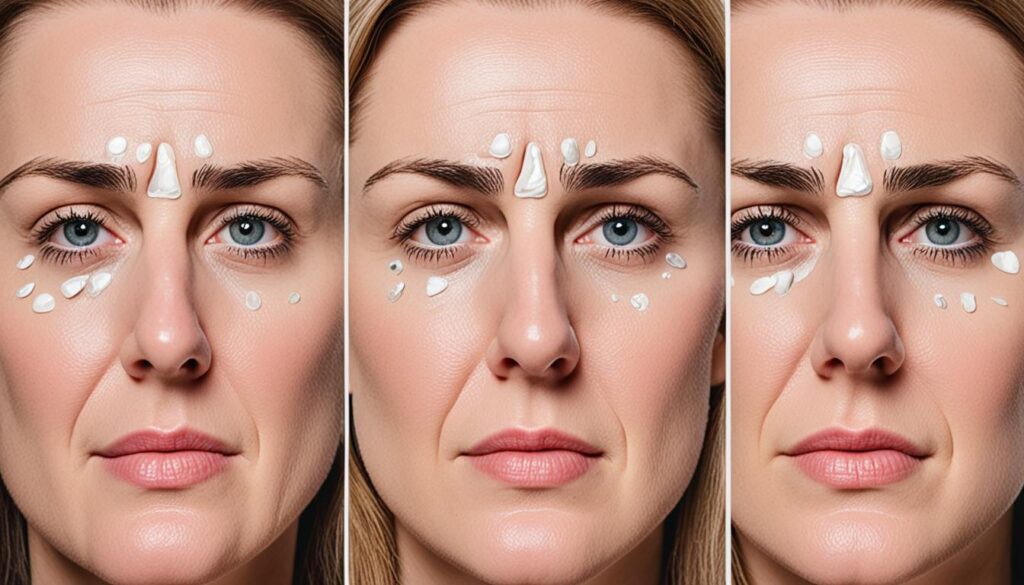Welcome to our comprehensive guide on Bell’s Palsy, a condition that can suddenly weaken the muscles on one side of your face. Also known as acute peripheral facial palsy of unknown cause, Bell’s Palsy is characterized by facial paralysis, drooping of the mouth, difficulty closing the eye, drooling, and pain around the jaw or ear. While the exact cause remains unknown, experts believe that swelling and inflammation of the facial nerve play a role in its development.
If you or someone you know is experiencing these symptoms, it’s important to seek medical help as soon as possible, as Bell’s Palsy can present similar symptoms to a stroke. Understanding the symptoms and recovery process can help you navigate this condition with confidence.
Key Takeaways:
- Bell’s Palsy causes sudden weakness in the muscles on one side of the face.
- Symptoms include facial paralysis, drooping of the mouth, difficulty closing the eye, drooling, and pain around the jaw or ear.
- Most people recover within a few weeks to six months, but some may experience long-term effects.
- It’s important to seek medical help to rule out a stroke if paralysis is observed.
- Treatment options include corticosteroids, antiviral medicines, eye care, and physical therapy.
Table of Contents
ToggleWhat is Bell’s Palsy and Who Gets It?
Bell’s palsy is an unexplained episode of facial muscle weakness or paralysis that typically affects only one side of the face. This condition can occur in anyone, but it is most commonly observed in individuals aged between 15 and 60 years. Interestingly, Bell’s palsy affects both men and women equally, without any gender bias.
Several risk factors contribute to the development of Bell’s palsy. These include pregnancy, upper respiratory infections like the flu or a cold, diabetes, high blood pressure, and obesity. Moreover, individuals with a family history of recurrent attacks are also susceptible, indicating a possible genetic link to the condition.
| Risk Factors | Prevalence |
|---|---|
| Pregnancy | Increased risk |
| Upper respiratory infections | Common trigger |
| Diabetes | Elevated risk |
| High blood pressure | Risk factor |
| Obesity | Potential trigger |
| Family history of recurrent attacks | Risk factor |
Understanding the risk factors associated with Bell’s palsy is crucial for early identification and prompt medical intervention. By recognizing these factors, healthcare professionals can provide targeted support and management strategies tailored to an individual’s unique circumstances.

Causes and Triggers of Bell’s Palsy
Bell’s Palsy is a condition characterized by sudden weakness or paralysis of the muscles on one side of the face. While the exact cause of Bell’s Palsy is unknown, it is often associated with viral infections. Several viruses have been linked to the development of Bell’s Palsy, including herpes simplex, herpes zoster, infectious mononucleosis, cytomegalovirus, adenovirus, and others.
In addition to viral infections, there are other triggers that can contribute to the development of Bell’s Palsy. Trauma, such as an injury to the face or head, can lead to facial nerve damage and subsequent paralysis. Exposure to toxins, such as certain medications or chemicals, has also been identified as a potential trigger. Furthermore, individuals with underlying conditions like diabetes, high blood pressure, and certain autoimmune diseases may have a higher risk of developing Bell’s Palsy.
It is important to note that Bell’s Palsy itself is not contagious. It is not spread from person to person, even if they have direct contact with someone affected by the condition.

Symptoms and Diagnosis of Bell’s Palsy
When it comes to bell’s palsy symptoms and obtaining an accurate diagnosis is crucial for timely treatment and management. Understanding the signs can help you distinguish Bell’s Palsy from other conditions and seek appropriate medical care.
Common Symptoms of Bell’s Palsy
Bell’s Palsy often manifests with the following symptoms:
- Sudden weakness or paralysis on one side of the face
- Drooping of the mouth
- Difficulty making facial expressions
- Drooling
- Pain around the jaw or ear
- Increased sensitivity to sound
- Headache
- Loss of taste
- Changes in tear and saliva production
If you experience any form of paralysis, especially on one side of the face, it is crucial to consult a healthcare professional. Although Bell’s Palsy is not a life-threatening condition, it is essential to rule out a stroke or other underlying causes. Timely diagnosis and treatment can contribute to better outcomes.
Diagnosing Bell’s Palsy
Diagnosing Bell’s Palsy typically involves a comprehensive evaluation of symptoms and a thorough medical examination. Your doctor will carefully assess the facial paralysis, consider your medical history, and inquire about any associated pain or discomfort.
While physical examination and clinical observation are often enough to diagnose Bell’s Palsy, additional tests may be recommended to rule out other conditions. These tests can include:
- Electromyography (EMG): This test measures the electrical activity of the facial muscles, helping to assess nerve functionality.
- Blood tests: Blood tests can help exclude other potential causes of facial paralysis, such as infections or autoimmune disorders.
- Imaging: In certain cases, imaging tests like an MRI or CT scan may be ordered to rule out other conditions that may mimic the symptoms of Bell’s Palsy.
While these tests may supplement the diagnosis process, they are typically not necessary for every Bell’s Palsy case. Your healthcare provider will determine the most appropriate diagnostic approach based on your specific situation.
Key Takeaways:
- Bell’s Palsy is characterized by sudden weakness or paralysis on one side of the face, along with other associated symptoms.
- It is important to seek medical attention if you experience any form of paralysis to rule out more serious conditions like stroke.
- Diagnosis of Bell’s Palsy is primarily based on symptoms, although additional tests may be conducted to confirm the diagnosis and rule out other potential causes.
Treatment Options for Bell’s Palsy
When it comes to Bell’s Palsy, the treatment options available vary depending on the severity of symptoms. In most cases, the condition resolves on its own without the need for medical intervention. However, certain treatments can help accelerate the recovery process and alleviate discomfort.
Corticosteroids are often prescribed to reduce inflammation and swelling of the facial nerve. These medications can effectively speed up the healing process and improve facial muscle function.
If a viral infection is suspected as the cause of Bell’s Palsy, antiviral medicines may be used in conjunction with corticosteroids to help fight the underlying infection and prevent further damage.
To alleviate pain and discomfort associated with Bell’s Palsy, analgesics can be used. Additionally, applying moist heat to the affected area can help reduce inflammation and promote healing.
Eye care is of utmost importance in managing Bell’s Palsy. To protect the affected eye from drying out and potential complications, it is crucial to keep the eye lubricated with eye drops or ointment. Regular blinking exercises can also help maintain eye moisture.
Physical therapy plays a vital role in the recovery of Bell’s Palsy. Facial exercises and stimulation techniques can help promote nerve regeneration and restore normal muscle function. Additionally, alternative therapies such as acupuncture and relaxation techniques may be considered to aid in the overall recovery process.
It is important to consult with a healthcare professional to determine the appropriate treatment options based on individual symptoms and needs.

| Treatment Options | Description |
|---|---|
| Corticosteroids | Reduce inflammation and swelling of the facial nerve |
| Antiviral Medicines | Used if a viral infection is suspected |
| Analgesics | Alleviate pain and discomfort |
| Moist Heat | Reduce inflammation and promote healing |
| Eye Care | Protect the affected eye from drying |
| Physical Therapy | Facial exercises and stimulation techniques |
| Alternative Therapies | Acupuncture and relaxation techniques |
Complications and Long-Term Effects of Bell’s Palsy
While most cases of Bell’s Palsy resolve within a month without complications, severe cases can lead to various complications and long-term effects. These can significantly impact the affected individual’s quality of life and require additional medical attention.
Complications:
- Irreversible damage to the facial nerve: In some cases, Bell’s Palsy can cause permanent damage to the facial nerve. This damage may result in persistent weakness or paralysis of the facial muscles.
- Irregular regrowth of nerve fibers: Sometimes, the regrowth of nerve fibers after Bell’s Palsy can be irregular, leading to involuntary muscle contractions. These contractions can cause facial twitching or spasms.
- Partial or complete blindness of the eye: Excessive dryness of the eye due to the inability to close it properly can result in partial or complete blindness. Proper eye care is crucial to prevent this complication.
Long-Term Effects:
- Lopsided face: Bell’s Palsy can result in facial asymmetry, causing one side of the face to appear droopy or lopsided.
- Crooked smile: The facial muscle weakness or paralysis can lead to a crooked smile, making it challenging to express emotions naturally.
- Involuntary facial movements: Some individuals may experience involuntary movements in the affected facial muscles.
- Tightness of facial or neck muscles: Long-term effects may include tightness or stiffness in the facial or neck muscles.
To manage these complications and long-term effects, a multidisciplinary approach involving physicians, physical therapists, and other healthcare professionals may be necessary. Treatments, such as physical therapy, facial exercises, medication, and surgical interventions, can help improve facial function and minimize the impact of these complications on daily life.

It is important for individuals with Bell’s Palsy to seek ongoing medical care to monitor their progress and address any lingering symptoms or concerns. While the majority of cases resolve fully, understanding potential complications and long-term effects can help individuals make informed decisions about their treatment and recovery journey.
Bell’s Palsy Recovery and Prognosis
When it comes to Bell’s Palsy, the prognosis is generally positive, and most individuals can expect to experience a full recovery within a few weeks to months. Signs of recovery often become apparent through improved muscle tone and facial movements. However, it’s important to note that some individuals may experience persistent symptoms or long-term effects.
To aid in the recovery process, following the recommended treatments and therapies is crucial. These may include:
- Corticosteroids: Medications that help reduce inflammation, allowing for faster healing.
- Physical therapy: Exercises and techniques to stimulate and strengthen the facial muscles.
- Eye care: Taking steps to protect the affected eye from dryness and potential damage.
Regular follow-up appointments with a healthcare provider are essential for monitoring progress and addressing any lingering symptoms. This ongoing care ensures that individuals receive the necessary support and guidance throughout their recovery journey.
Remember, each case of Bell’s Palsy is unique, and the recovery timeline may vary. By staying proactive, adhering to the recommended treatments, and maintaining regular communication with a healthcare professional, you can maximize your chances of a successful recovery.
| Recovery Signs | Duration |
|---|---|
| Improved muscle tone | A few weeks |
| Facial movements | Months |
| Persistent symptoms | Varies |
| Long-term effects | Possible |
Living with Bell’s Palsy
Bell’s Palsy is a temporary condition that affects the muscles on one side of the face, causing weakness or paralysis. While the condition itself is not permanent, it is important to take proper care of the affected eye and support your overall well-being during the recovery process.
Eye Care
One of the key aspects of living with Bell’s Palsy is ensuring proper eye care. The weakness or paralysis of the facial muscles can affect the eye’s ability to blink and close properly, which can lead to complications such as corneal scratching and dryness.
To prevent these complications, your healthcare provider may recommend using eye drops or ointments to keep your eye moist during the day and protecting it at night. This can help alleviate discomfort and reduce the risk of further damage. Additionally, it’s important to protect your eye from dust and debris by wearing sunglasses or using protective eyewear when necessary.
Managing Stress and Rest
Living with Bell’s Palsy can be challenging, both physically and emotionally. Managing stress and getting adequate rest are important aspects of supporting your overall well-being during the recovery process.
Additionally, getting enough rest is crucial for your body to heal and recover. Make sure to prioritize sleep and create a peaceful environment conducive to relaxation.
Supportive Measures
While there is no specific cure for Bell’s Palsy, there are various supportive measures that can aid in your recovery. Physical therapy may be recommended to stimulate the facial nerve and improve muscle strength and control.
In addition, alternative therapies such as acupuncture and facial exercises have shown some benefits in promoting nerve regeneration and improving facial function. However, always consult with your healthcare provider before trying any alternative therapies.
It’s important to remember that everyone’s experience with Bell’s Palsy is unique, and recovery timelines can vary. By taking proper care of your eye, managing stress, getting adequate rest, and exploring supportive measures, you can support your recovery and minimize the impact on your daily life.
Bell’s Palsy vs. Stroke: Knowing the Difference
Bell’s palsy and stroke share similar symptoms, including facial paralysis and difficulty closing the eye. However, there are significant differences between the two conditions that can help differentiate them.
In Bell’s palsy, symptoms typically come on suddenly and only affect one side of the face. On the other hand, a stroke can cause numbness or weakness on one side of the body in addition to facial symptoms.
There are also other distinguishing factors that can help identify whether it is Bell’s palsy or a stroke. Changes in taste, eye watering, and sensitivity to sound are more commonly associated with Bell’s palsy.
To summarize, while Bell’s palsy and stroke can present with similar facial symptoms, the sudden onset and exclusive involvement of one side of the face, along with other associated factors, can help differentiate Bell’s palsy from a stroke.
Distinguishing Factors between Bell’s Palsy and Stroke:
- Bell’s Palsy:
- Sudden onset
- Facial paralysis on one side of the face
- Changes in taste
- Eye watering
- Sensitivity to sound
- Stroke:
- Numbness or weakness on one side of the body
- Facial symptoms in addition to other body symptoms
Bell’s Palsy Recovery Signs and Duration
Recovering from Bell’s Palsy can be a gradual process, and it’s important to recognize the signs that indicate progress. The first signs of recovery often become evident within a few weeks.
- Improved muscle tone: As your facial muscles start to regain their strength, you may notice improved muscle tone. This can manifest as increased control over facial movements and a reduction in drooping or weakness.
- Facial movements: The ability to make facial expressions is a positive sign of recovery. You may observe improvements in your ability to smile, blink, and raise your eyebrows.
While some people experience a complete recovery within a few months, the duration of Bell’s Palsy can vary from person to person. It is essential to be patient and not get discouraged if the recovery process takes longer for you.
On average, full recovery from Bell’s Palsy can take anywhere from three to six months.
If your symptoms persist or worsen over time, it is crucial to seek further evaluation and treatment options from a healthcare provider. They can provide personalized guidance and recommend therapies that may accelerate your recovery.
Is Bell’s Palsy Permanent?
While most people with Bell’s Palsy make a full recovery, some may experience long-term effects or lingering symptoms. These can include a lopsided face, crooked smile, involuntary facial movements, and tightness of facial or neck muscles. In some cases, cosmetic procedures or surgery may be recommended to address these effects. Regular follow-up with a healthcare provider is important to monitor progress and address any ongoing concerns.
Potential Long-Term Effects of Bell’s Palsy
Bell’s Palsy can have lasting consequences that impact a person’s facial appearance and muscle control. Some individuals may exhibit:
- A lopsided face
- A crooked smile
- Involuntary facial movements
- Tightness of facial or neck muscles
These long-term effects can significantly affect an individual’s self-confidence and quality of life. Therefore, it is crucial to consult with a healthcare professional to explore potential treatment options and address any concerns.
Treatment Options for Long-Term Effects
Cosmetic procedures or surgery may be recommended to improve the appearance and function of the face for individuals experiencing long-term effects of Bell’s Palsy. These interventions aim to restore symmetry, reduce involuntary movements, and alleviate muscle tightness.
It is important to note that the appropriateness of these treatment options varies based on individual circumstances. Consulting with a healthcare provider who specializes in facial nerve disorders can help determine the most suitable course of action.
Ongoing Monitoring and Support
Regular follow-up appointments with a healthcare provider are crucial for individuals with long-term effects of Bell’s Palsy. These appointments allow for monitoring of progress, the evaluation of treatment effectiveness, and addressing any ongoing concerns or symptoms.
Additionally, healthcare providers can provide support and guidance, offer recommendations for managing symptoms, and ensure comprehensive care throughout the recovery process.
Conclusion
Bell’s Palsy is a temporary condition that affects the muscles on one side of your face, causing weakness or paralysis. Although the exact cause is unknown, it is believed to be related to inflammation and swelling of the facial nerve, often triggered by viral infections. Most people recover fully within a few weeks to months with the help of treatment options such as corticosteroids and physical therapy.
However, it is important to note that complications and long-term effects can occur in some cases. These may include irreversible damage to the facial nerve, involuntary muscle contractions, and partial or complete blindness of the affected eye due to excessive dryness. Therefore, regular follow-up with a healthcare provider is crucial to monitor your progress and address any lingering symptoms or concerns.
If you are experiencing any symptoms of Bell’s Palsy, it is vital to seek medical help to rule out other conditions such as stroke. Timely diagnosis and appropriate treatment can significantly improve your chances of full recovery. Remember to take care of your affected eye by using eye drops or ointments to keep it moist and protect it from scratching and dryness.
In conclusion, while Bell’s Palsy can be a challenging condition to navigate, with proper care and treatment, most individuals can regain full facial function and lead a normal life. Stay informed, follow the recommended interventions, and consult with your healthcare provider for personalized guidance throughout your recovery journey.
FAQ
What is Bell’s Palsy?
Bell’s Palsy is a condition that causes sudden weakness or paralysis of the muscles on one side of the face.
What are the symptoms of Bell’s Palsy?
Symptoms of Bell’s Palsy include facial paralysis, drooping of the mouth, difficulty closing the eye, drooling, and pain around the jaw or ear.
What causes Bell’s Palsy?
The exact cause of Bell’s Palsy is unknown, but it is believed to be related to swelling and inflammation of the facial nerve. Viral infections and certain triggers such as trauma and toxins may also play a role.
How is Bell’s Palsy diagnosed?
Diagnosis of Bell’s Palsy is usually based on symptoms, but additional tests such as electromyography, blood tests, and imaging may be done to rule out other conditions.
What are the treatment options for Bell’s Palsy?
Treatment for Bell’s Palsy depends on the severity of symptoms. It may include corticosteroids to reduce inflammation, antiviral medicines, pain relief, eye care, and physical therapy.
Are there any complications or long-term effects of Bell’s Palsy?
Complications of Bell’s Palsy can include irreversible damage to the facial nerve, irregular regrowth of nerve fibers, and partial or complete blindness of the eye. Long-term effects may include a lopsided face, crooked smile, and involuntary facial movements.
What is the prognosis for Bell’s Palsy?
Most people with Bell’s Palsy experience full recovery within a few weeks to months. Regular follow-up with a healthcare provider is important to monitor progress and address any lingering symptoms.
How should I take care of my eye if I have Bell’s Palsy?
It is important to protect the affected eye from drying and potential complications. Eye drops or ointments may be recommended to keep the eye moist, and protecting it from dust and debris is crucial.
How is Bell’s Palsy different from a stroke?
While Bell’s Palsy and stroke can have similar symptoms such as facial paralysis, Bell’s Palsy affects only one side of the face and does not cause numbness or weakness on one side of the body.
How long does it take to recover from Bell’s Palsy?
Most people start to see improvements in their symptoms within a few weeks, and full recovery can take anywhere from 3 to 6 months.
Is Bell’s Palsy permanent?
Bell’s Palsy itself is not a permanent condition, but some people may experience long-term effects or lingering symptoms.
Source Links
About The Author

This article is medically reviewed by Dr. Chandril Chugh, Board-Certified Neurologist, providing expert insights and reliable health information.
Dr. Chandril Chugh is a U.S.-trained neurologist with over a decade of experience. Known for his compassionate care, he specializes in treating neurological conditions such as migraines, epilepsy, and Parkinson’s disease. Dr. Chugh is highly regarded for his patient-centered approach and dedication to providing personalized care.
→ Book a consultation to discover which remedies suit your needs best.




